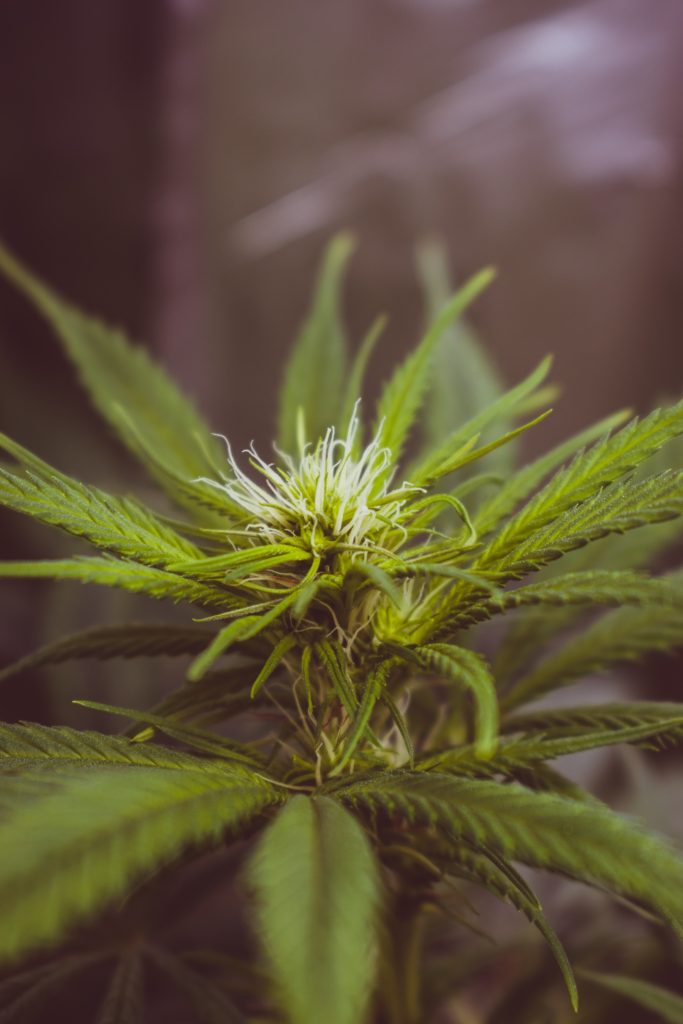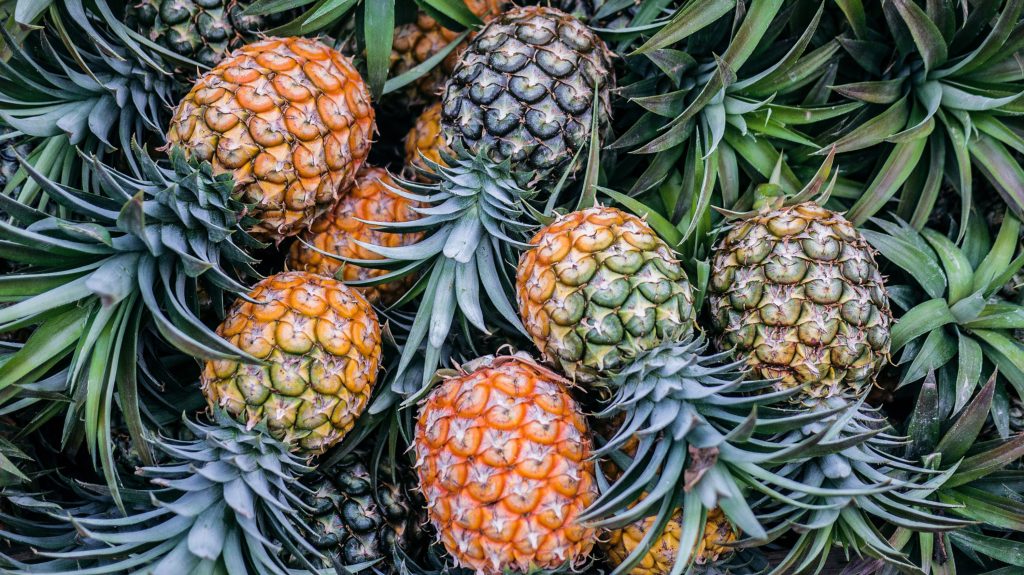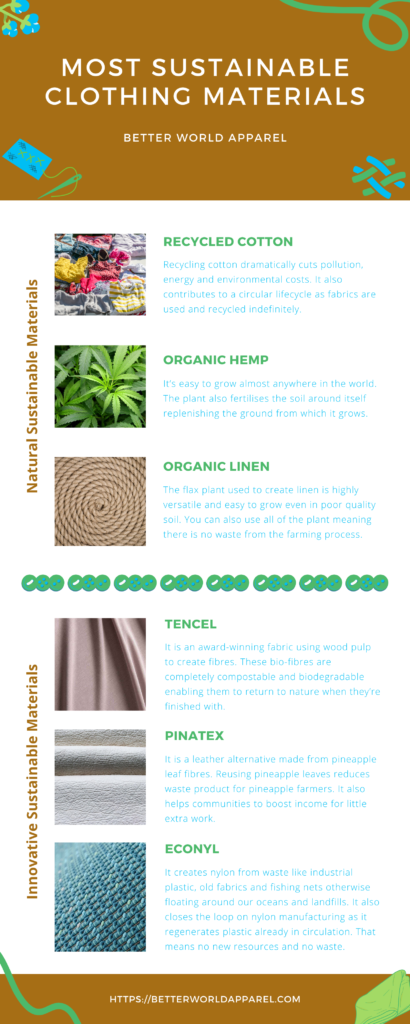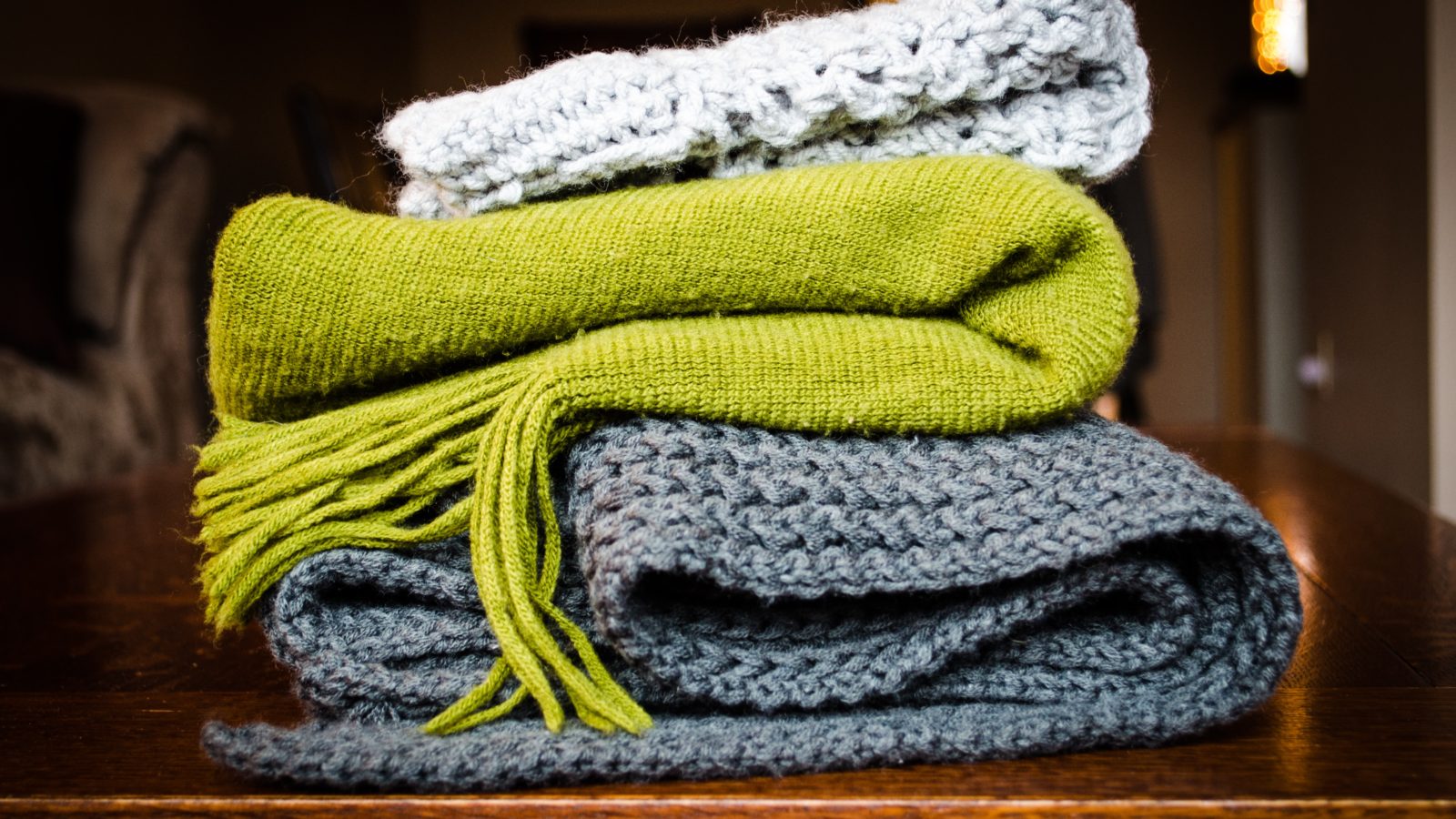How do you know what materials are sustainable? I can get overwhelmed sometimes with identifying eco-friendly choices, especially clothing. There’s organic, natural, recycled and heaps of innovative man-made options, but which materials are actually sustainable? Is any one better than the others? With over 300,000 tonnes of UK clothing ending up in landfills every year, it is more important than ever to start thinking more sustainably.
So let’s explore the most sustainable materials for clothing. From recycled fabrics to inspiring new innovative creations.
Natural Sustainable Materials for Clothing
Recycled Cotton

Recycled cotton is arguably the most sustainable clothing material. There’s a lot of reason to put it top of the pile when it comes to sustainability in fashion.
Cotton is the most common fabric used in the clothing industry, in fact, cotton is used in nearly half of textile fabrics.
The natural fibre is almost perfect for clothing as it holds strong yet lightweight and breathable properties. Plus it grows naturally from the ground, so any cotton is sustainable, right?
Unfortunately, fast-fashion heaps demand on the cotton industry and as a result is destroying its eco-friendly credentials. Farming cotton to keep up with this demand is intensive, requiring a lot of land and gallons of water.
It can take up to 20,000 gallons of water to make one pair of jeans.
Here’s the good news.
We already have millions of tons of cotton in existence. We can recycle what we already have. Cotton is easy to recycle, so when old clothing wears out it can quickly be turned into new garments.
This is cool because it requires no more raw materials and creates a closed-loop manufacturing process.
Recycling cotton dramatically cuts pollution, energy and environmental costs. Products take on a circular lifecycle as fabrics can be used, recycled, and used again.
The Higgs Materials Sustainability Index backs up these credentials ranking recycled cotton as more sustainable than normal and even organic cotton.
Recycled cotton reduces the strain on water, energy and habitat destruction while keeping cotton out of the landfill.
I think you can quickly see why we think it’s super sustainable.
Organic Hemp

Hemp has long been championed as an incredibly sustainable material.
These days hemp is emerging into the mainstream appearing in a tonne of your everyday products.
It’s actually a remarkable plant offering an almost limitless selection of applications including food, building material, cosmetics and of course fabrics.
Hemp has been a vital resource for creating clothing for hundreds of years, and for good reason.
So what makes hemp so amazing?
Well, it’s easy to grow almost anywhere in the world. Funnily enough hemp is pretty laidback requiring little water or resources to grow.
It’s also great for the surrounding soil. Replenishing the nutrients from ground in which it grows.
Hemp is one of our oldest fabrics and it’s simple to understand why. A resource that is easy to grow and turn into a variety of durable materials.
Strong and breathable it’ll keep you warm in cold weather and cool in hot. Pretty impressive, right?
Hemp, sustainable and suitable for every occasion.
Organic Linen

Humans have been creating linen throughout the course of history, a little like hemp.
If we’ve learnt anything from hemp, then there’s probably a good reason for it.
The flax plant used to create linen is highly versatile and easy grow.
Once again it is an incredibly sustainable material to farm requiring little water or maintenance.
Flax is a fairly unfussy plant, even happy to grow in poor quality soil.
You can also use the whole of the plant meaning nothing goes to waste.
Think of your linen bed sheets, they have perfect properties for fabrics.
It’s strong, durable and lightweight. Linen can take a lot of punishment and is very absorbent with the ability to expel bacteria.
Another fantastic, natural, and sustainable material.
Innovative Sustainable Materials for Clothing
Naturally made sustainable material is amazing, often it can be made with little to no environmental damage. Plus they have biodegradable properties built in.
However, we’ve come to rely on the many benefits of other man-made materials, particularly plastic.
Combining sustainability and man-made materials is no easy task but innovative products continue to pop up every day. Here are some of the most innovative sustainable materials:
Tencel

Tencel is an award-winning fabric using wood pulp to create fibres. Manufacturing occurs in a responsible and sustainable manner in order to maintain the environment’s natural balance.
These bio-fibres are completely compostable and biodegradable enabling them to return to nature when they’re finished with. Clothing using Tencel with no nylons or glues can even be buried in your back yard to compost!
The Tencel brand uses the hashtag #FeelsSoRight to highlight what the material represents.
It’s sustainable and responsible which continues to be a growing concern for consumers.
Of course, the bottom line is the quality of the fabric, and Tencel feels so right because it’s high quality, soft to the touch, versatile, breathable and absorbent.
What’s not to like?
Pinatex

Leather never goes out of fashion and while it is sustainable in many ways, especially durability, it requires animals for production.
Pinatex is a leather alternative making a name for itself.
Ananas Anam manufactures the material and as french speakers might be able to guess it is made from pineapple. Pineapple leaf fibres to be exact.
These leaves are already a by-product of farming so it unlocks some awesome benefits for the environment and the farmers. Firstly, finding a use for pineapple leaves reduces waste product for pineapple farmers. It also helps communities to boost income for little extra work.
Pinatex offers low environmental impact while ensuring social responsibility. Nice.
Econyl
Econyl uses recycled materials which, as we discovered with recycled cotton, offers major benefits.
This innovative project creates nylon from waste like industrial plastic, old fabrics and fishing nets otherwise floating around our oceans and landfills.
It also closes the loop on nylon manufacturing as it regenerates plastic already in circulation.
That means no new resources and no waste.
Nylon comes under a lot of pressure from a sustainability standpoint, and with good reason, as it is a crude oil by-product.
But when recycled it suddenly becomes a highly sustainable material that can be used to create durable clothing.
This eco-nylon is doing an inspiring job to repurpose plastic although it is still important to be aware that it sheds microplastics into the world.
Not perfect, but a step forward.
Sustainable Materials for Clothing, Plenty of Choices
There’s no real excuse for not choosing more sustainable materials in our clothing.
As you can see sustainable fabrics offer perfect properties for most day to day products.
The human race survived for thousands of years before man-made materials like plastic appeared.
We can all start by recycling our old clothes for the materials to be repurposed. And buying new clothing, well, sustainable choices grow every single day, whether it’s recycled cotton or hemp.



 The Difference Between Fast Fashion Vs Slow Fashion?
The Difference Between Fast Fashion Vs Slow Fashion?
Leave a Reply